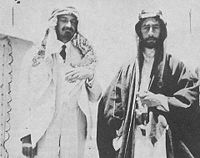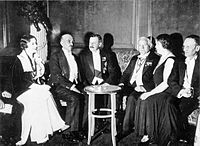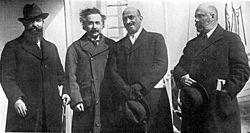- Chaim Weizmann
-
Chaim Azriel Weizmann
חיים עזריאל ויצמן
1st President of Israel In office
17 February 1949 – 9 November 1952Prime Minister David Ben-Gurion Preceded by Position established
(Provisional State Council)Succeeded by Yitzhak Ben-Zvi 2nd Chairman of the Provisional State Council of Israel In office
16 May 1948 – 17 February 1949Prime Minister David Ben-Gurion Preceded by David Ben-Gurion Succeeded by Became President Personal details Born 27 November 1874
Motal, Russian EmpireDied 9 November 1952 (aged 77)
Rehovot, IsraelNationality Israeli Political party General Zionists Spouse(s) Vera Weizmann Children 2 Profession Chemist Religion Judaism Signature 
Chaim Azriel Weizmann, Hebrew: חיים עזריאל ויצמן, (27 November 1874 – 9 November 1952) was a Zionist leader, President of the Zionist Organization, and the first President of the State of Israel. He was elected on 1 February 1949, and served until his death in 1952.
Weizmann was also a chemist who developed the ABE-process, which produces acetone through bacterial fermentation. He founded the Weizmann Institute of Science in Rehovot, Israel.
Contents
Biography
Weizmann was born in the village of Motal near Pinsk in Belarus (at that time part of the Russian Empire). He was one of 15 children. His father was a timber merchant. Until the age of 11, he attended a traditional heder. At the age of 11, he entered high school in Pinsk.
Weizmann studied chemistry at the Polytechnic Institute of Darmstadt, Germany, and University of Freiburg, Switzerland. In 1899, he was awarded a doctorate with honors. In 1901, he was appointed assistant lecturer at the University of Geneva and, in 1904, senior lecturer at the University of Manchester.[1]
He was married to Vera Weizmann.[2] The couple had two sons. The younger one, Flight Lt Michael Oser Weizmann, serving as a pilot in the British No. 502 Squadron RAF, was killed when his plane was shot down over the Bay of Biscay.[3]
His nephew Ezer Weizman also became president of Israel. Chaim Weizmann is buried beside his wife in the garden of his home at the Weizmann estate, which is located on the grounds of Israel's science research institute, The Weizmann Institute of Science.
In 2005, he was voted the 45th-greatest Israeli of all time, in a poll by the Israeli news website Ynet to determine whom the general public considered the 200 Greatest Israelis.[4]
Political career
Weizmann missed the first Zionist conference, held in 1897 in Basel, Switzerland, because of travel problems, but he attended each one thereafter. Beginning in 1901, he lobbied for the founding of a Jewish institution of higher learning in Palestine. Together with Martin Buber and Berthold Feiwel, a document was presented to the Fifth Zionist Congress, highlighting this need especially in the fields of science and engineering. This idea would later be crystallized in the foundation of the Technion - Israel Institute of Technology in 1912.[5]
In 1904, Weizmann became a chemistry lecturer at the University of Manchester and soon became a leader among British Zionists. At that time in Manchester, Arthur Balfour was a Conservative MP representing the district, as well as Prime Minister, and the two met during one of Balfour's electoral campaigns. Balfour supported the concept of a Jewish homeland, but felt that there would be more support among politicians for the then-current offer in Uganda. Following mainstream Zionist rejection of that proposal, Weizmann was credited later with persuading Balfour, then the Foreign Minister, for British support to establish a Jewish homeland in Palestine, the original Zionist demand.[6]
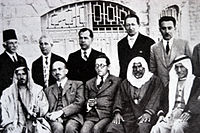 Chaim Weizmann (sitting, second from left) at a meeting with Arab leaders at the King David Hotel, Jerusalem, 1933. Also pictured are Haim Arlosoroff (sitting, center), Moshe Shertok (Sharett) (standing, right), and Yitzhak Ben-Zvi (standing, to Shertok's right).
Chaim Weizmann (sitting, second from left) at a meeting with Arab leaders at the King David Hotel, Jerusalem, 1933. Also pictured are Haim Arlosoroff (sitting, center), Moshe Shertok (Sharett) (standing, right), and Yitzhak Ben-Zvi (standing, to Shertok's right).
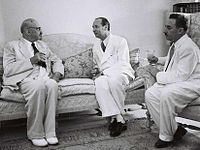 Weizmann (left) with first Turkish ambassador to Israel, Seyfullah Esin (c), and Foreign Minister Moshe Sharett, 1950
Weizmann (left) with first Turkish ambassador to Israel, Seyfullah Esin (c), and Foreign Minister Moshe Sharett, 1950
Weizmann first visited Jerusalem in 1907, and while there, he helped organize the Palestine Land Development Company as a practical means of pursuing the Zionist dream. Although Weizmann was a strong advocate for "those governmental grants which are necessary to the achievement of the Zionist purpose" in Palestine, as stated at Basel, he persuaded many Jews not to wait for future events, stating:[citation needed]
- A state cannot be created by decree, but by the forces of a people and in the course of generations. Even if all the governments of the world gave us a country, it would only be a gift of words. But if the Jewish people will go build Palestine, the Jewish State will become a reality—a fact.
In 1917, he became president of the British Zionist Federation; he worked with Arthur Balfour to obtain the milestone Balfour Declaration, which stated in part that the British government "views with favour the establishment in Palestine of a national home for the Jewish people ... it being clearly understood...". A founder of so-called Synthetic Zionism, Weizmann supported grass-roots colonization efforts as well as high-level diplomatic activity. He was generally associated with the centrist General Zionists and later sided with neither Labour Zionism on the left nor Revisionist Zionism on the right. In 1917, he expressed his view of Zionism in the following words,
- We have [the Jewish people] never based the Zionist movement on Jewish suffering in Russia or in any other land. These suffering have never been the mainspring of Zionism. The foundation of Zionism was, and continues to be to this day, the yearning of the Jewish people for its homeland, for a national center and a national life.
On 3 January 1919, he and the Hashemite Prince Faisal signed the Faisal-Weizmann Agreement attempting to establish favourable relations between Arabs and Jews in the Middle East. At the end of the month, the Paris Peace Conference decided that the Arab provinces of the Ottoman Empire should be wholly separated and the newly conceived mandate-system applied to them.[7] Shortly thereafter, both men made their statements to the conference.
After 1920, he assumed leadership in the World Zionist movement, serving twice (1920–31, 1935–46) as president of the World Zionist Organization. In 1921, Weizmann went along with Albert Einstein for a fund-raiser to establish the Hebrew University in Jerusalem and support the Technion – Israel Institute of Technology. At this time, brewing differences over competing European and American visions of Zionism, and its funding of development versus political activities, caused Weizmann to clash with Louis Brandeis.[8] During the war years, Brandeis headed the precursor of the Zionist Organization of America, led in fund-raising for Jews in Europe (and Palestine[9] In early October [1914] the USS North Carolina arrived in Jaffa harbor with money and supplies provided by Schiff, the American Jewish Committee, and the Provisional Executive Committee for General Zionist Affairs, then acting for the WZO, which had been rendered impotent by the war. Although Weizmann retained Zionist leadership, the clash led to the departure from the movement of Brandeis and other prominent leaders. By 1929, there were about 18,000 members left in the ZOA, a massive decline from the high of 200,000 reached during the Brandeis years.[10]
In 1936 he addressed the Peel Commission, set up by Stanley Baldwin, whose job it was to consider the working of the British Mandate of Palestine. The Commission published a report that, for the first time, recommended partition, but the proposal was declared unworkable and formally rejected by the government. Weizmann and David Ben-Gurion accepted the partition and its logic. This was the first official delineation and declaration of a Zionist vision opting for a new, artificial state with a majority of Jewish population, alongside the existing state[dubious ] with its Arab majority. The Arab leaders, headed by Haj Amin al-Husseini, rejected the plan.
Weizmann's efforts to integrate Jews from Palestine in the war against Germany resulted in the creation of the Jewish Brigade, which fought mainly in the Italian front. After the war he grew embittered by the rise of violence in Palestine and by the terrorist tendencies amongst followers of the Revisionist fraction. His influence within the Zionist movement decreased, yet he remained overwhelmingly influential outside of Palestine (Eretz Israel). In his Presidential Statement at the last Zionist Congress that he attended (Basle, 9 December 1946) he unequivocally said:
- Massada, for all its heroism, was a disaster in our history; It is not our purpose or our right to plunge to destruction in order to bequeath a legend of martyrdom to posterity; Zionism was to mark the end of our glorious deaths and the beginning of a new path leading to life.[11]
First president of Israel
He met with United States President Harry Truman and worked to obtain the support of the United States for the establishment of the State of Israel. Weizmann became the first President of Israel in 1949.
Scientific career
Weizmann lectured in chemistry at the University of Geneva between 1901 and 1903, and later taught at the University of Manchester. He became a British subject in 1910, and while a lecturer at Manchester he became famous for discovering how to use bacterial fermentation to produce large quantities of desired substances. He is considered to be the father of industrial fermentation. He used the bacterium Clostridium acetobutylicum (the Weizmann organism) to produce acetone. Acetone was used in the manufacture of cordite explosive propellants critical to the Allied war effort (see Royal Navy Cordite Factory, Holton Heath). Weizmann transferred the rights to the manufacture of acetone to the Commercial Solvents Corporation in exchange for royalties.[12]
After the Shell Crisis of 1915 during World War I, he was director of the British Admiralty laboratories from 1916 until 1919. During World War II, he was an honorary adviser to the British Ministry of Supply and did research on synthetic rubber and high-octane gasoline. (Formerly Allied-controlled sources of rubber were largely inaccessible owing to Japanese occupation during World War II, giving rise to heightened interest in such innovations).
Concurrently, Weizmann devoted himself to the establishment of a scientific institute for basic research in the vicinity of his sprawling estate, in the town of Rehovot. Weizmann saw great promise in science as a means to bring peace and prosperity to the area. As stated in his own words :
"I trust and feel sure in my heart that science will bring to this land both peace and a renewal of its youth, creating here the springs of a new spiritual and material life. [...] I speak of both science for its own sake and science as a means to an end."[13]
His efforts led in 1934 to the creation of the Daniel Sieff Research Institute, which was financially supported by an endowment by Israel Sieff in memory of his late son. Weizmann actively conducted research in the laboratories of this institute, primarily in the field of organic chemistry. In 1949 the Sieff Institute was renamed the Weizmann Institute of Science in his honor. Weizmann's success as a scientist and the success of the Institute he founded make him an iconic figure in the heritage of the Israeli scientific community today.
Published work
- Chaim Weizmann (1949). Trial and Error: The Autobiography of Chaim Weizmann. Jewish Publication Society of America.
See also
References
- ^ Biography of Chaim Weizmann
- ^ Jewish Women Encyclopedia, Vera Weizmann
- ^ Casualty Details Commonweath War Graves Commission
- ^ גיא בניוביץ' (20 June 1995). "הישראלי מספר 1: יצחק רבין – תרבות ובידור". Ynet. http://www.ynet.co.il/articles/0,7340,L-3083171,00.html. Retrieved 10 July 2011.
- ^ TECHNION: The Story of Israel's Institute of Technology. Carl Alpert. ISBN: 0-87203-102-0
- ^ Current Biography 1942, pp 877–80. The story goes that Weizmann asked Balfour, "Would you give up London to live in Saskatchewan?" When Balfour replied that the British had always lived in London, Weizmann responded, "Yes, and we lived in Jerusalem when London was still a marsh."
- ^ International Boundary Study, Jordan – Syria Boundary, No. 94 – 30 December 1969, p.10 US Department of State
- ^ Ben Halpern, A Clash of Heroes: Brandeis, Weizmann, and American Zionism (Studies in Jewish History) Oxford University Press, 1987
- ^ Michael Brown, The Israeli-American connection: its roots in the yishuv, 1914–1945, p.26
- ^ Donald Neff, Fallen Pillars: U.S. Policy towards Palestine and Israel since 1945 [1]
- ^ [The Letters and Papers of Chaim Weizmann, Series B. Papers Volume II December 1931 – April 1952, Paper 87, pp.636–637, Yad Chaim Weizmann (1984), Library of Congress Catalog No. 82-17442
- ^ Local Industry Owes Much to Weizmann
- ^ Chaim Weizmann Lab,Dept. of Organic Chemistry Weizmann Institute
External links
- Chaim Weizmann Jewish Agency site
- Chaim Weizmann Israel Ministry of Foreign Affairs
- Weizmann Institute of Science
- The Chaim Weizmann Laboratory on Chaim Weizmann's laboratory at the Weizmann Institute (includes info and links on Weizmann's scientific work)
Heads of State of Israel 

Chairmen of
Provisional State CouncilPresidents Chaim Weizmann (1949 – 1952) • Yitzhak Ben-Zvi (1952 – 1963) • Zalman Shazar (1963 – 1973) • Ephraim Katzir (1973 – 1978) • Yitzhak Navon (1978 – 1983) • Chaim Herzog (1983 – 1993) • Ezer Weizman (1993 – 2000) • Moshe Katsav (2000 – 2007) • Shimon Peres (2007 – present)Chaim Weizmann · Abba Eban · Meyer Weisgal · Albert Sabin · Israel Dostrovsky · Michael Sela · Aryeh Dvoretzky · Haim Harari · Ilan Chet · Daniel ZajfmanCategories:- 1874 births
- 1952 deaths
- People from Motal
- Belarusian Jews
- Israeli people of Belarusian origin
- Israeli Jews
- Cordite
- Jews in Ottoman and British Palestine
- Jewish scientists
- Presidents of Israel
- Israeli chemists
- Academics of the Victoria University of Manchester
- Burials in Israel
- Weizmann Institute faculty
- Jewish inventors
- Russian emigrants to Israel
- Presidents of Weizmann Institute of Science
- Berlin Institute of Technology alumni
- General Zionists politicians
Wikimedia Foundation. 2010.


